The AHS Blog

The smallest clockmaker’s workshop in the world
This post was written by Peter de Clercq
What I like about museums is the same thing I like about public parks. You can go in and be happy without having to worry about costs, upkeep and security, as private collectors or garden owners have to.
What’s more: entrance to many of the best museums is free. Deciding to walk in and have a look is just as easy as taking that walk in the park.
There are many museums with historic clocks and watches, and those in Great Britain are listed on the AHS website. There are enough to keep you busy for a long while.
If you are in the City of London, for example to see St Paul’s Cathedral, why not also take a look in the nearby Clockmakers’ Museum at Guildhall. Gathered in one ground-floor gallery you will find the treasures assembled over the years by the honourable Worshipful Company of Clockmakers. It was established in 1631 and is still active, which makes it the oldest surviving horological institution in the world.
Among my favourite showcases is the one filled with horological curiosities [Fig 1]. The object at the bottom is a model of a clockmakers’ workshop [Fig 2]. It was made around 1930 by the London antique dealer Percy Webster, who was Master of the Clockmakers’ Company in 1926 – they have a new Master every year!
It is indeed a curiosity, as it is not known why it was made, nor what period he intended to represent. But it’s fun to kneel down and look at this horological equivalent of a doll’s house. The only thing missing is the miniature clockmaker himself.
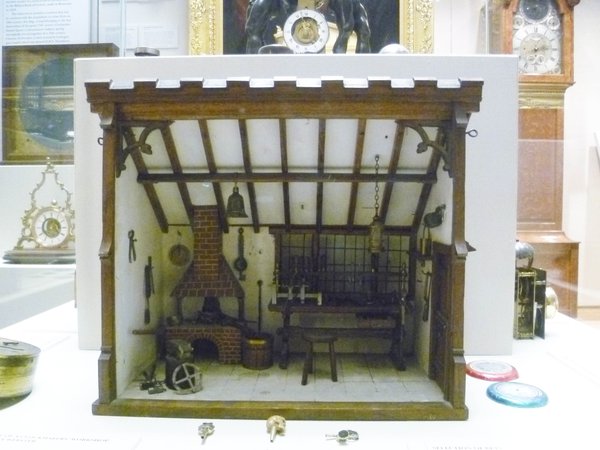
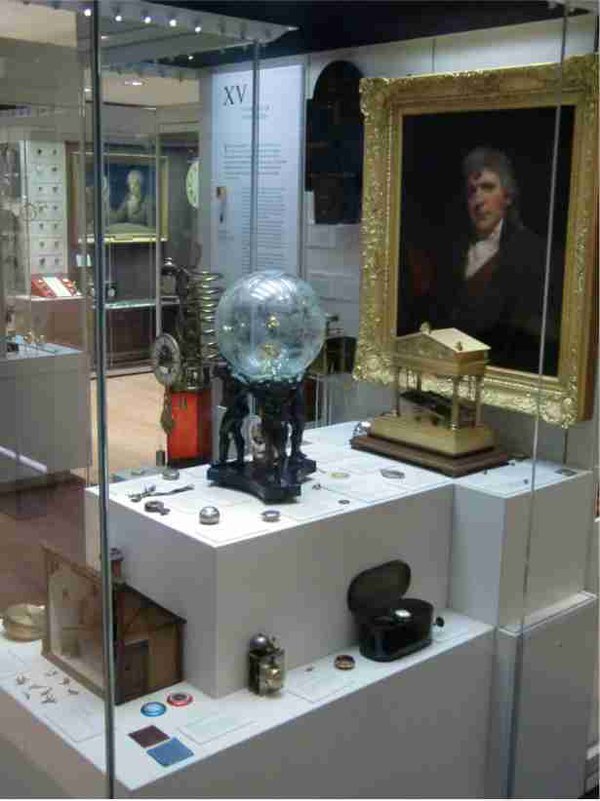
The AHS in Fiji
This post was written by James Nye
No, Council hasn’t decided to mount an all-expenses paid Pacific tour. But my curiosity was certainly piqued recently.
I have never been to Fiji. I don’t think I could quickly find it on a map, but I certainly think of it as exotic paradise, far, far away.
It was something of a shock a few weeks ago to be contacted by a representative of the government, looking for help in restoring a Synchronome installation to working order. Lots of pictures arrived and it rapidly became obvious this was no small scale system. It lies at the heart of Government Buildings in Suva the capital (see photo below).
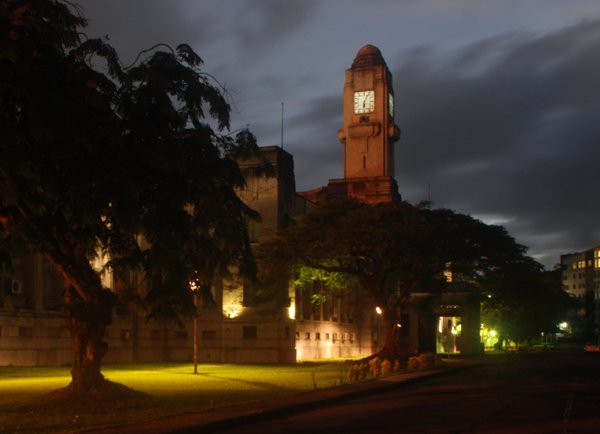
The building complex was completed in the late 1930s and the Fijians were lucky enough at the time to play host to Frank Hope-Jones, managing director of Synchronome, who was nearing the end of a six-month, round-the-world cruise. He secured the contract to supply a master clock, forty impulse dials, and the impressive turret clock installation, pictured below.
You can find more details of the trip, and everything else about Synchronome in Robert Miles’ Synchronome – Masters of Electrical Timekeeping, published last year by the AHS.
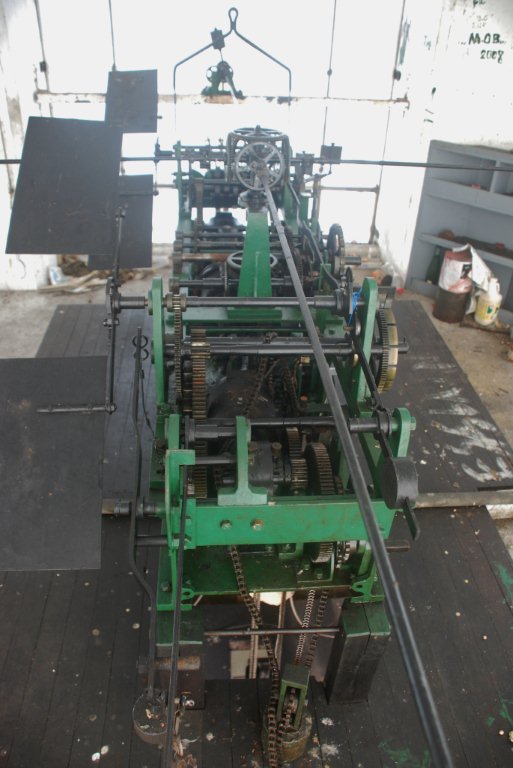
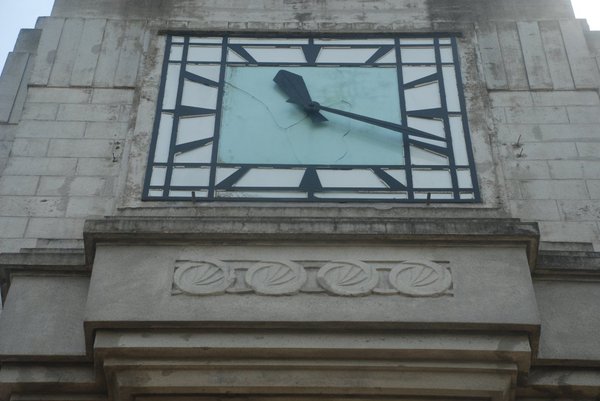
This large beast is actually badged Synchronome on the frame, but initial assessments suggest it is actually a Thwaites mechanism that has been adapted.
The striking and chiming trains are standard, but the going train has been modified to form a half-minute release system in which the distant master clock (No. 2564) controls the release of the train. The peal of bells was supplied by Mears and Stainbank.
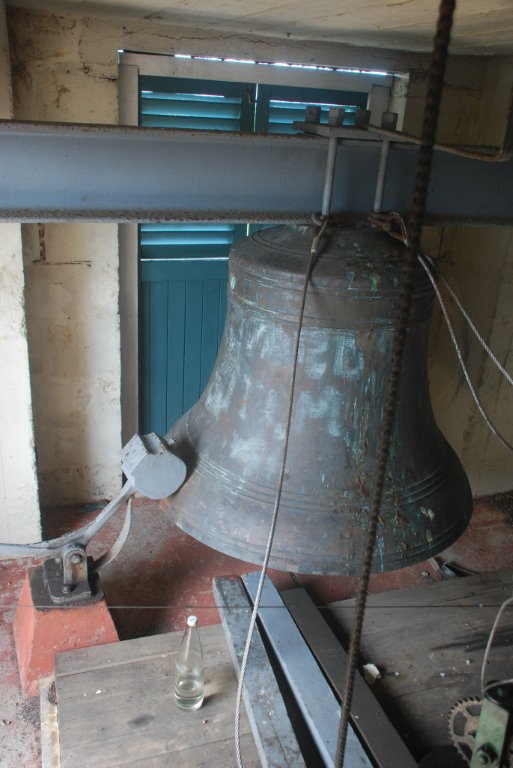
The society and its Electrical Timekeeping Group are keen to conserve clocks and installations in as original condition as possible. It appears that Hope-Jones’s legacy in this instance has survived relatively well – in terms of the turret clock and its associated master clock at least – and this looks like a wonderful opportunity to keep an original installation operating and in situ.
Discussions are underway between the Fijians and Keith Scobie-Youngs of the AHS Turret Clock Group and proprietor of the Cumbria Clock Co. to see how practically any help can be rendered at such a great distance and some imaginative solutions have started bubbling to the surface.
I am delighted that the Fijians should have been in touch and am pleased that we were well equipped to research some history for them and provide some first ideas for preserving their heritage. I shall hope to update this story in the coming months.
West Dean do the Hipp-toggle
This post was written by Matthew Read
At West Dean College, once in a while we take the opportunity to pack away the historic clocks, let our hair down and have some good clean horological fun making new stuff. New making is very much part of our wider philosophy – learning through doing – and what informs and prepares students for the restoration element of our work.
Following a chance discovery of a copy of Practical Mechanics 1936, complete with blueprints and instructions of how to build a Hipp-toggle pendulum clock, we could not resist the challenge.
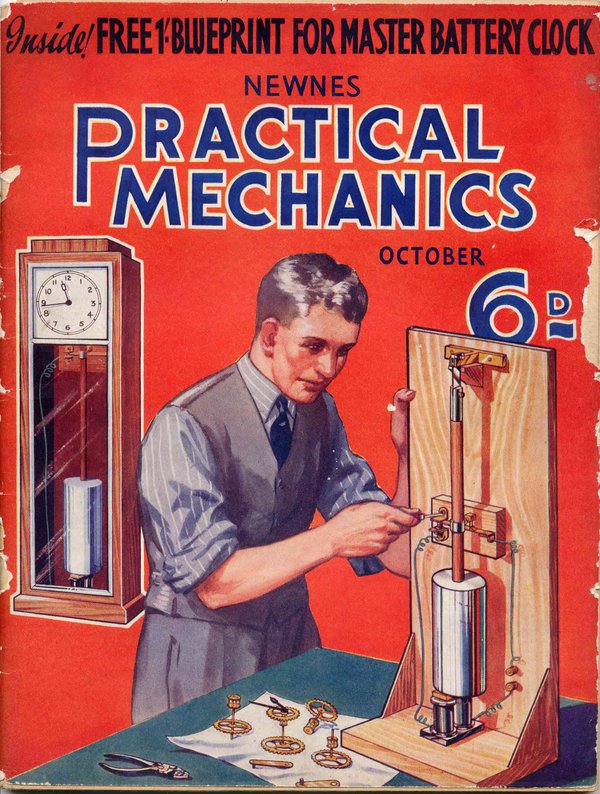
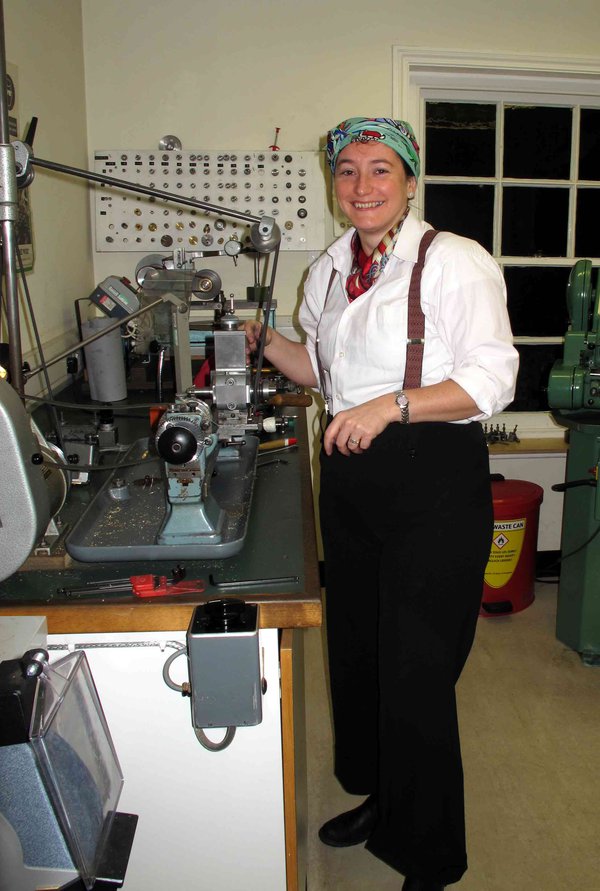
The hipp-toggle system is one of relative simplicity, or so we thought so attempted the project in a single day. Well, relative simplicity is a relative thing, yet at the end of a frenetic day we had our clock ticking – complete with hand-made electro-magnetic coils, rather splendid (we feel) shellac lacquered, knurled brass terminals, pendulum bob and the like. With a nod to modernity, the pendulum rod is of carbon fibre tube and the electrical circuit sports blue LEDs.
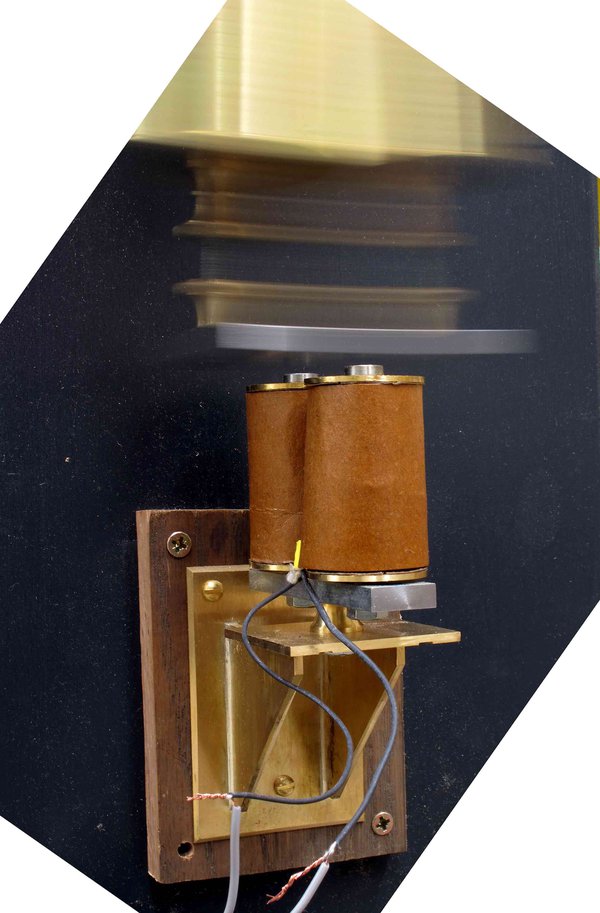

So not to take ourselves all too seriously, we dressed for the day in proper kit, took regular breaks for tea and mandatory pipe smoking and workshop discussion was of the latest technological advances of the time – 1936.
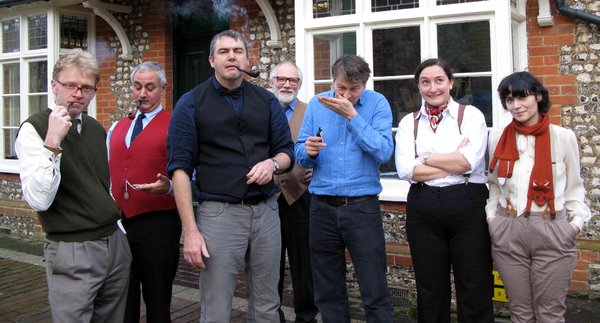
See the completed clock and find out more about how this project will help student bursary funds in a future post.
The work of Matthias Hipp features in the excellent ‘Time Machines’ temporary exhibition at the Museum of the History of Science, Oxford.
Don’t forget David Thompson’s lecture next week
This post was written by David Rooney
If you came to the AHS inaugural event at the Royal Astronomical Society in January, you’ll know our new venue in Burlington House makes for a superb evening’s entertainment – and it’s free.
Our second event is next week, so mark it in your diaries now. On Thursday 15 March, AHS Chairman and British Museum curator David Thompson will give the next in our series of talks on ‘The Great Collectors’. This time it’s all about the industrialist, financier and banker, J. P. Morgan.
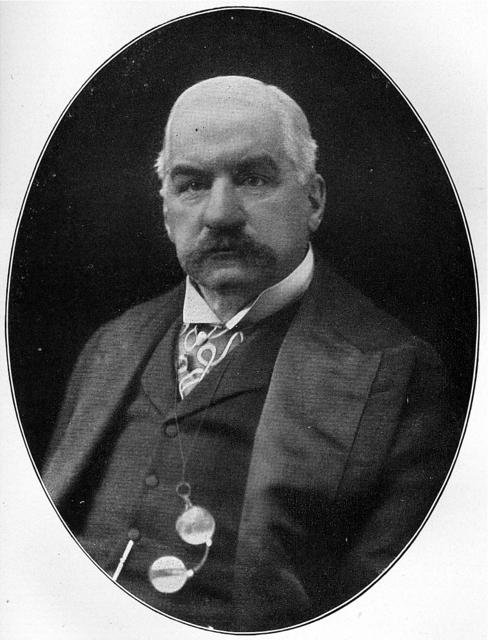
Whilst Morgan’s business interests are well known, it is his collecting activity that will be in the spotlight on Thursday. Best remembered as a collector of art, gemstones and rare books, he also amassed a considerable number of clocks and watches, concentrating on 16th to 18th century decorative pieces.
This talk promises to provide a sumptuous insight into Morgan’s horological treasures, which David will compare against similar material in other collections. For anybody interested in watches, clocks and the mind of the collector, this will be an evening to remember.
Doors will open at 5.30pm for tea with the talk beginning at 6.15pm. There will be a drinks reception afterwards in the Library. Nearest tube stations are Green Park and Piccadilly Circus.
Thanks to the generous sponsorship of The Clockworks , the event is free – but if you would like to make a contribution to support the work of the AHS further, please do get in touch. We’d love to hear from you.
English thirty-hour longcase clocks
This post was written by David Thompson
As well as being Chairman of the AHS, I am also Curator of Horology at the British Museum. In my museum capacity recently I have been engaged in documenting a large and fascinating collection of English thirty-hour duration longcase clocks presented to the Museum by Michael Grange in November 2010. This extensive collection covers the period c.1700 to about 1840 and contains clocks from a wide variety of locations around Great Britain.
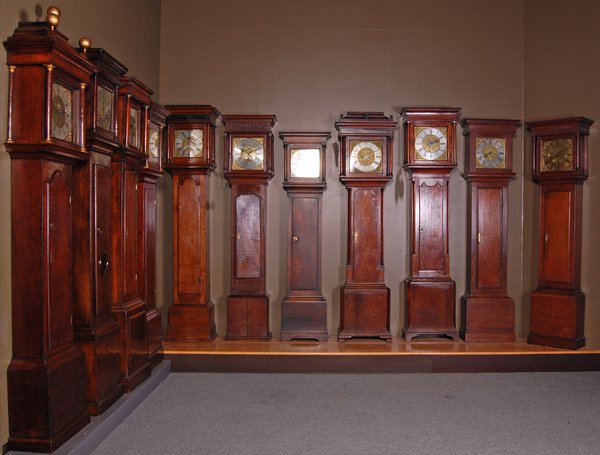
Today, these clocks still have a place in countless homes both in this country and abroad and there is no doubt that they each have a story to tell. At so many levels they reflect the tastes of those who first owned them back in the 18th century and show characteristics which are often peculiar to the locality in which they were made.

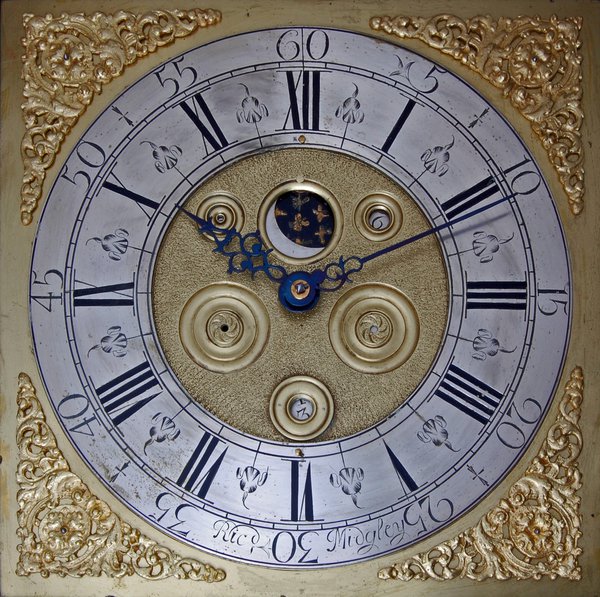
Recently, I was looking at an example by Richard Midgley of Ripponden. The stained-oak case with a forward-sliding flat-topped hood is typical of about 1740 but, unusually, there is no opening door on the hood and no mask inside to surround the dial. This is not all – this clock is eccentric in several other respects.
The five minute numeral has an embellishment in the form of an engraved flower and a further flower can be seen next to the 30 minute numeral. It seems likely that these have been engraved to mask errors.
In addition to this, the clock is pretending to be something it is not. The ringed holes near to the IX and III are not winding holes, as would be expected in an eight-day duration clock, but are simply dummies to give that impression. Keeping up with the Jones’s was clearly not an uncommon concept even in the 18th century.
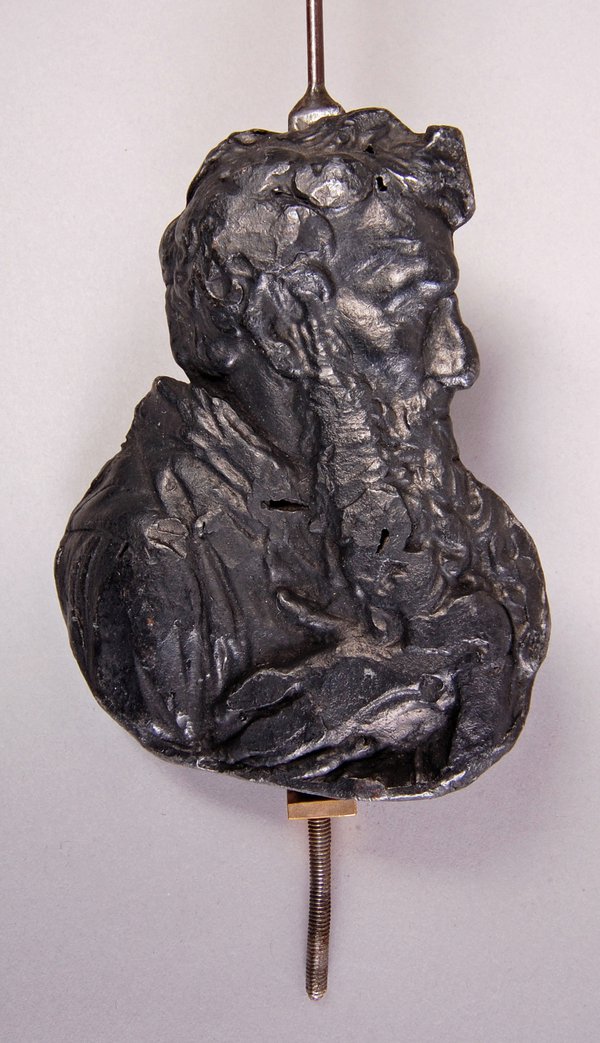
There is a final twist in the slightly eccentric nature of this clock. The pendulum bob is of a type which I have never seen before – in the form of a portrait bust. Assuming that this is the original pendulum, could this be a portrait of the maker Richard Midgley. Does it relate to the first owner? In any event it is a rare feature.
The Grange collection is a splendid addition to the collections in the British Museum and provides a unique opportunity to study and learn about the story of longcase clockmaking around the country – 'affording delightful prospects' as Gerard Hoffnung once said.
We the accumulators and the responsibilities
This post was written by Andrew King
Many of us spend an endless number of hours researching the story of timekeeping from various scientific and historical points of view as well as studying the lives of the makers of clocks and watches through the same wide spectrum.
There is a challenge and excitement in research as we trawl through libraries and record offices, scan the internet and trace living descendents who, surprisingly even after a period of possibly many decades or even centuries, can still turn up documents or even artefacts of significant historical importance.
All this leads us to as close an understanding of times past as we are ever going to be able to achieve. Although we can never really fully understand what life could have been like in previous times, with a certain diligence in trudging through archives we can begin to gain a sense of life as well as a tangible sniff from the stench of the streets.

In historical research it is as important to have an open mind as it is to have a persistent and untiring curiosity that questions every fact and figure until a reasoned acceptance can be reached. Although a quest for new sources of information is of paramount importance, it is equally necessary to read and read again all the established works as well as more recent studies which although maybe only allied to our core interest, may nonetheless be able to add a reflection if not some new knowledge.
Over a period of years there will be an accumulation of research – in short, an archive. It is at this point that the real work starts because those years of research now need to be sifted into a ground plan for publication.
Without writing and publishing as much as a lifetime’s work can be thrown away. The published work may be anything from a paper offered to our Journal to a mighty tome. Everything is of potential importance and everything can be considered as a contribution to our history of time.
The dissemination of knowledge is the heart beat of history that opens up the past to contribute to the world we live in today to enable us to project our thoughts into the future.
Oral history in electrical timekeeping
This post was written by James Nye
In the electrical timekeeping world, whilst things kicked off in the mid-nineteenth century, there was considerable development all the way through the twentieth century, with the distribution of time becoming commonplace, and various technologies emerging to replace others over time.
There are many people alive who have worked at the heart of those emerging technologies – or witnessed their emergence – technologies such as atomic timekeeping, or the use of quartz as an oscillator, starting in research labs and ending up on countless millions of wrists.
At the first of the AHS London Lecture Series meetings at the Royal Astonomical Society in January, I was delighted to announce the launch of a project we are sponsoring in the Electrical Group – to promote the recording of oral history. Witness programs exist in many fields and prove an invaluable way of recovering and recording the fascinating and highly personal insights of people who can genuinely say 'I was there.'
Lucas Elkin, of Cambridge University Library, has kindly offered to take the lead with this project, targeting individuals with the specialist and personal knowledge we want to tap, by way of a recorded (and relaxed) interview.
One of his first subjects will be Bob Miles, who spent his career working on the early development of quartz technology. We look forward to being able to point people to the transcribed records of these fascinating conversations.
We have a list of about a dozen candidates already identified, but if the trial is successful we shall be looking for more. If you any ideas, or want to get involved, please get in touch!
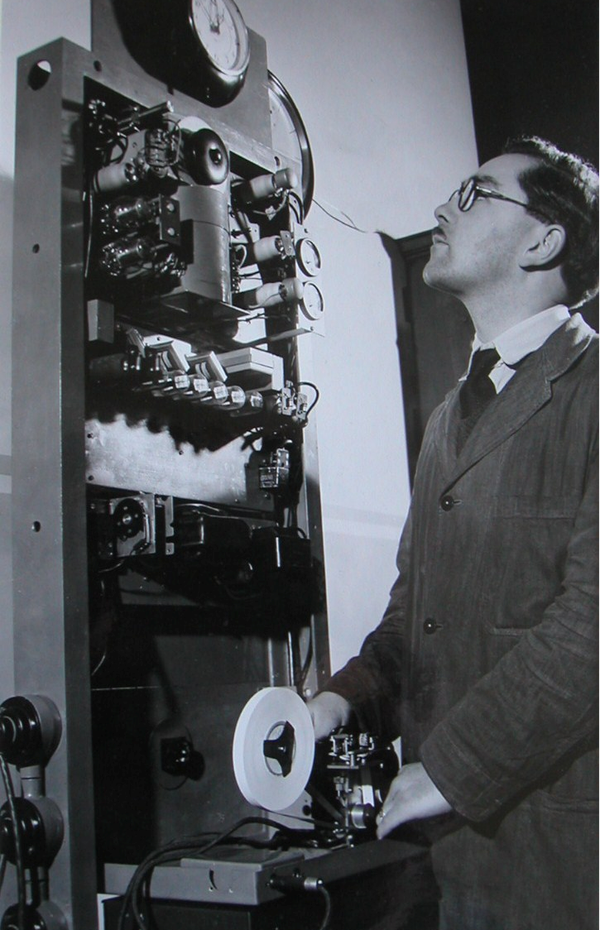
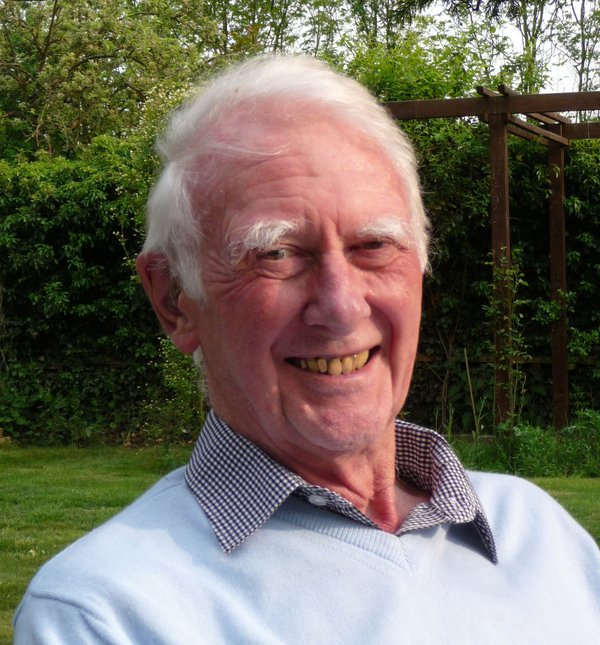
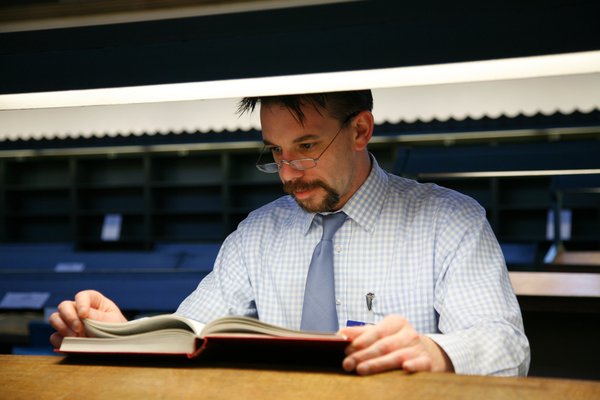
Time by wireless
This post was written by David Rooney
The current header picture at the top of our blog is from an Edwardian postcard entitled ‘Polurrian Cove and Hotel’. Here’s the full version.
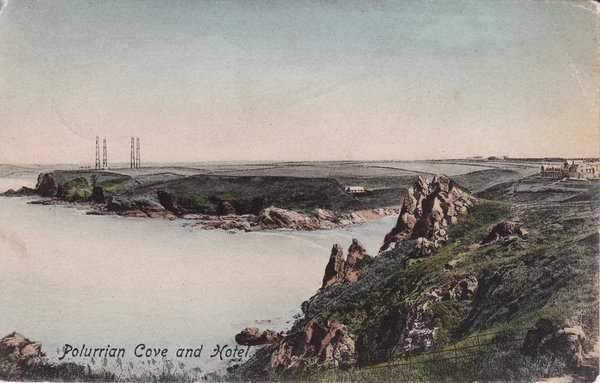
I love historic scenes like this which show modern technology set within seemingly timeless surroundings. Here, Marconi’s Poldhu wireless station looms in the background of a picturesque little bay in Cornwall.
This was the transmitter for the world’s first transatlantic radio message, received in Newfoundland, Canada, in December 1901.
One of the earliest uses of wireless communication was radio time signals. Experiments began in America in about 1904, with time signals from Paris’s Eiffel Tower being broadcast from 1909. Soon, standardised international codes were established, giving a much-needed boost to ships and many others who needed accurate time checks around the world.
Today, radio time signals are still very much with us. The BBC’s six-pips signal, inaugurated in 1924, is still accurate to a fraction of a second – as long as you’re listening on analogue. Coded time signals are sent out by the National Physical Laboratory from a transmitter in Cumbria, a system that began in 1927. And even the latest satellite navigation systems operate on super-precise radio time signals.
William Mitchell’s 1923 book, Time & Weather by Wireless, is a terrific read or, if you can’t get hold of a copy, I talk about the history of radio time in my 2008 book, Ruth Belville: The Greenwich Time Lady. And if you want to get more deeply involved, you might consider joining the AHS and its electrical timekeeping group. It’s full of people who think Edwardian postcards of Cornish transmitter masts are cool.
You do think the postcard’s cool, surely. No? It’s just me? Oh.
Horological research
This post was written by Jonathan Betts
Determined to ‘practice what we preach’, a number of us on the Council are currently involved in our own horological research; my project at the Royal Observatory Greenwich is the study of our enormous collection of marine chronometers.
The research will lead to the publication of a catalogue raisonne, ‘The Marine Chronometers at Greenwich’ in 2014, as part of the celebrations to mark the tercentenary of the passing of the great Longitude Act in 1714, and will form one of the series of Greenwich instruments catalogues published in recent years in conjunction with Oxford University Press.
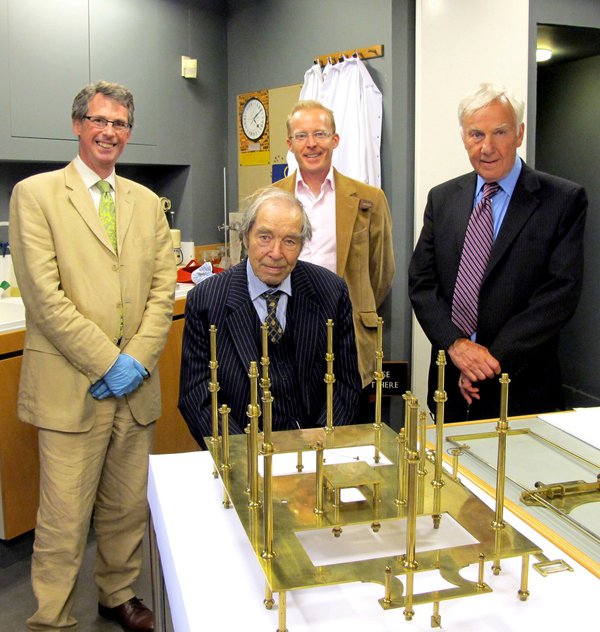
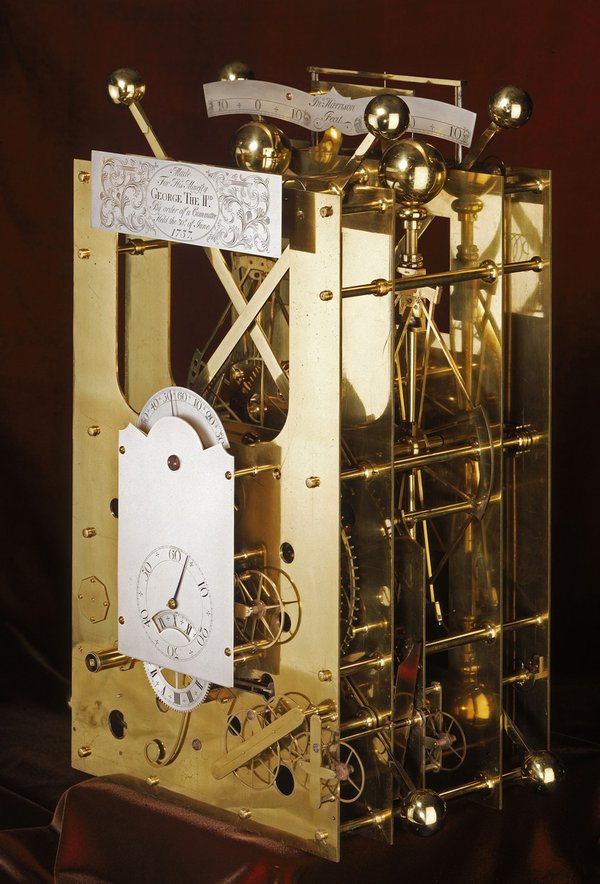
All the timekeepers by the great John Harrison have now been fully dismantled, studied, photographed and researched (and put back together!) and I am now slowly working my way through the rest of the collection, from early examples by John Arnold up to the 4 orbit Hamilton, the rare Model 21 marine chronometer adapted to aid pacific navigation.
One of the great challenges for the catalogue is to write a ‘spotters guide’ to help collectors, dealers and curators with the tricky question of ‘how to date and evaluate your marine chronometer’. In the early years there were obvious differences in evolution and from one maker to the next, but, from the 1840s, marine chronometers appear, at first glance, to change very little through into the 20th century.
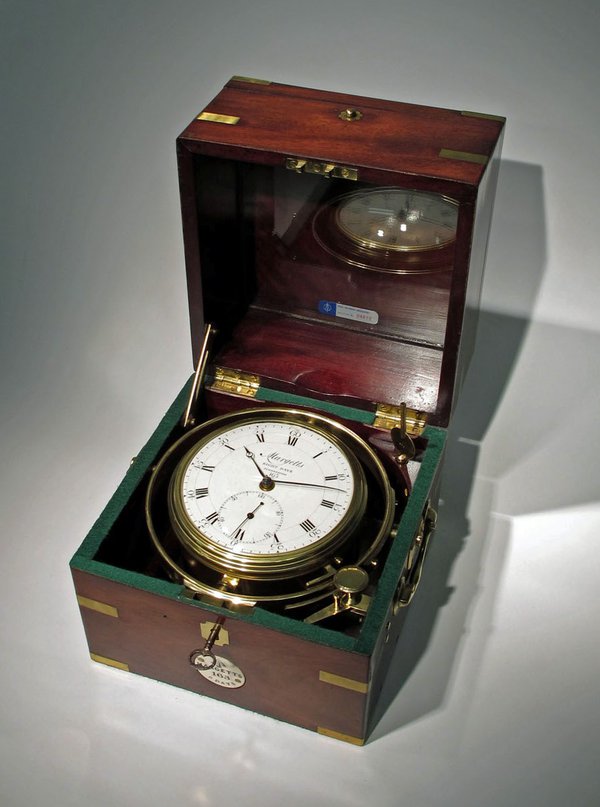
There are however many things to look out for, both in the movement and the box, which will enable a more sophisticated evaluation of a given chronometer. But be warned! These functional objects have often had considerable alteration and ‘upgrades’ over the years (lives depended on their being ‘up to date’, after all) and we should be prepared to accept, and dare one say rejoice in, instruments with a complex history. Later posts may expand on this interesting aspect.
First AHS event at Burlington House
This post was written by David Rooney
Our 2012 London Lecture Series kicked off in style last week, when over 100 AHS members and friends flocked to the Royal Astronomical Society at Burlington House, Piccadilly, for the inaugural event at our new venue.
This special event saw our usual single bi-monthly lecture replaced by a series of speakers offering reflections on objects and ideas in the story of time.
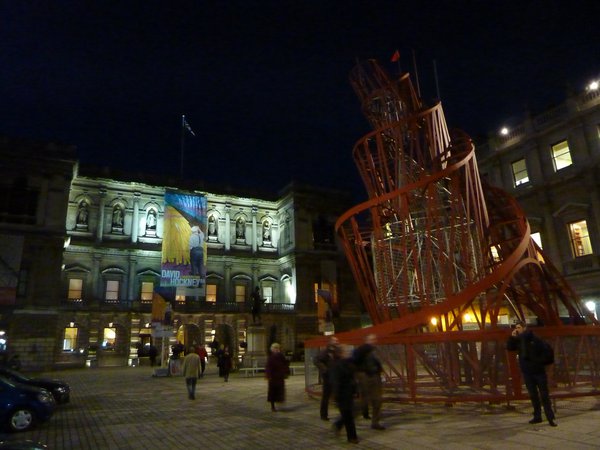
Sir Arnold Wolfendale, astronomer and AHS president, welcomed the society to the RAS, whilst founder member Michael Hurst surveyed our achievements since 1953. Chairman David Thompson looked forward to the coming year, then introduced a further six speakers, each assessing different aspects of the society’s interests.
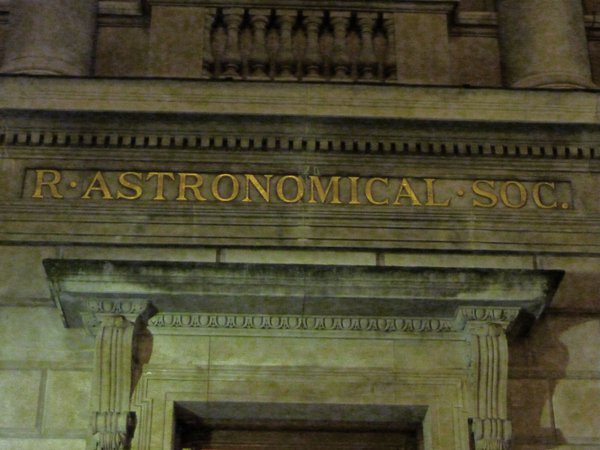
Jonathan Betts explored the study of domestic clocks, followed by David Penney considering issues in pocket and wristwatch history. Matthew Read offered a vision of the society’s role in conservation and material research, whilst Keith Scobie-Youngs outlined the challenges and opportunities offered by turret clocks. James Nye gave a sparkling presentation of the electric timekeeping group’s achievements over four decades, and the talks concluded with Andrew King assessing opportunities for future research.
The event proved exceptionally popular, with all tickets allocated well in advance and additional space being provided in the RAS council room, linked by video to the lecture theatre.
The talks were followed by a champagne reception generously sponsored by The Clockworks, a new gallery, conservation workshop, library and meeting space dedicated to electric timekeeping, launching in London later this year.
Our next London lecture will be held on 15 March, when David Thompson continues our series of talks on the great clock and watch collectors. It promises to be an enlightening event – look forward to seeing you there.
Welcome
This post was written by David Thompson
Welcome to the Antiquarian Horological Society Blog. This blog marks a new era in the activities of the society.
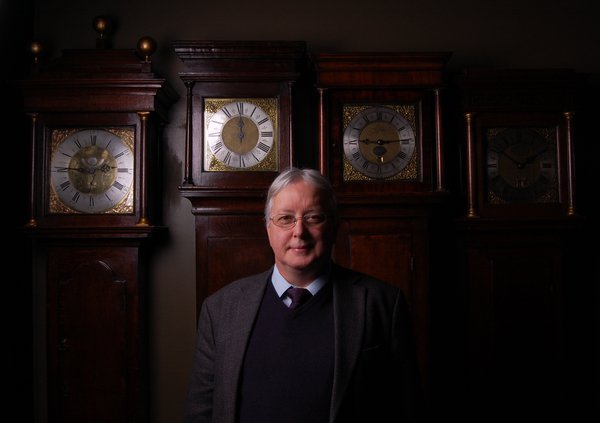
I should really be saying Welcome to the AHS blog. The AHS – The Story of Time is where we are now at the beginning of 2012.
There are many things to look forward to from the AHS. New books being published, a wonderful new venue – the Royal Astronomical Society, Burlington House – for our London meetings, as well as a year of lectures not only being held by our various active sections around the country, but also by the sections abroad, in Canada, Eire, the Netherlands and the United States.
The blog will include items for all those who have an interest in antiquarian horology, and those who didn’t know they had – until now. It will be about clocks and watches and the story of time in all its forms, from the earliest timekeepers.
I was once asked – 'What is it that so fascinates you about old clocks and watches?' 'Well,' I replied, 'where else will you find objects of beauty which also have a practical and sometimes vital function? What other objects tell stories about the history of technology, about the history of the people who made them and the people who owned them?'
That old clock which came from grandmother’s house and now lives in your front room – what do you know about it? You’ve known it since you were a child, but have never had much idea about how old it is.
Our society is all about knowing – or at least doing our best to know when and where clocks and watches were made and how they fit into the story of time. We look forward to items being presented on this blog which will intrigue, inform and entertain you.
Happy New Year and Welcome to the AHS Blog.
David Thompson
Chairman